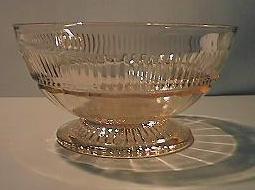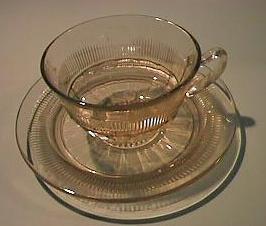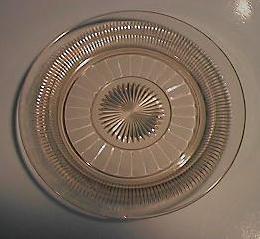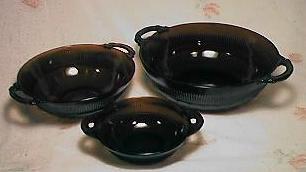

Hocking's Coronation
Written by Rosemary Trietsch
In the mid
1930's, the eyes of the world were turned toward England. King George V died in
January of 1936 leaving two sons: Edward VIII, who was next in line for the
throne, and George. Edward became king, but stunned the world 11 months later by
renouncing the throne in favor of American divorcee, Wallis Simpson.
It was not until May 1937 that England's new king, George VI, finally
ascended the throne. Using America's obsession with the monarchy to their
advantage, Hocking cleverly named one of the new glass patterns of 1936,
Coronation.
Hocking produced Coronation from 1936 to 1940. The main production was in pink with Royal Ruby added in 1939 (does the adjective 'royal' suddenly make more sense?). There was experimentation with a transparent green color, but only a few pieces have turned up outside Hocking's glass morgue. Some pieces can also be found in crystal.
Coronation is a small pattern, with only 9 different pieces made: a pitcher, tumbler, cup, and sherbet, a 6 inch and an 8-1/2 inch plate, and 3 different size bowls. The pitcher is the hardest piece to find and will carry a hefty price when you do see one. The tumbler, however, is perhaps the most popular piece in the pattern due to the fact that it's the fraternal twin to the Old Colony tumbler which sells for almost triple the price. Both tumblers are the same shape and have rays up the sides. But on the Coronation tumbler, the rays end in the distinctive fine rib band that's found on all Coronation pieces. Many Old Colony collectors are happy to 'settle' for the Coronation tumblers, which makes for a lot of people searching for the same piece.


Only
5 of the 9 pieces are found in Royal Ruby: the cup, 8-1/2 inch plate, and the 3
size bowls; 4-1/4 inch, 6-1/2 inch and 8 inch berry. Ruby cups were used on
crystal saucer/sherbet plates as Hocking once again allowed one piece to do
double duty. The ruby bowls would probably qualify as the most common pieces in
the pattern, but they're not easy to get at a good price. General antique
dealers recognize that they're nicer than the average 'red stuff' you find, but
haven't a clue what they are so you'll usually find them marked with some
outrageous price or description.
All three sizes of Ruby bowls have open handles with a scroll design similar to the fancy handled Cameo and Block Optic cups. In pink, these same bowls have a closed tab handle with a rayed design reminiscent of the pattern's fine rib band. The 4-1/4 inch bowl and the 8-inch bowl have also turned up in pink and green without handles. If you're counting, that makes 8 variations on 3 basic size bowls so you could argue that there are 14 pieces to the pattern if you want. (Of course, I'd just agree with you rather than start trouble....) The variations are most likely the result of the molds being reworked and replaced over the 4 years that the pattern was produced. As Royal Ruby was introduced toward the end of the pattern's run, it's probable that a new batch of molds was needed, thus a chance to add a more regal touch to this royal color and pattern.


Coronation is
an easy pattern to mix and match with whatever you're using on the table. I've
used my ruby bowls with everything from paper plates at barbecues to my Holiday
Lenox at Christmas. A pink luncheon or dessert set sparkles. If you're lucky
enough to have the pitcher and tumblers, you can certainly have a table setting
fit for a king.
Speaking
of which, if you're wondering about next month's pattern, I'll give you a hint:
Who was Edward VIII's mother?